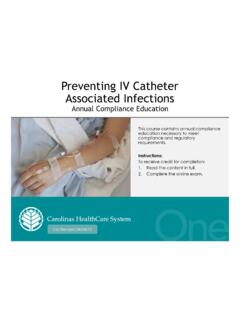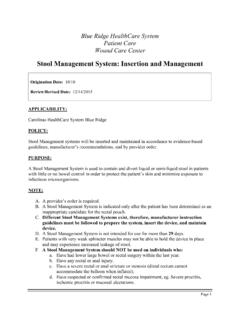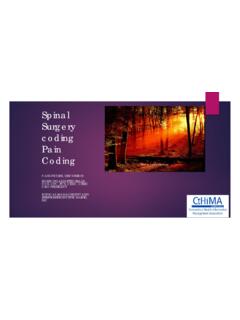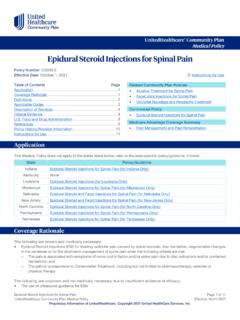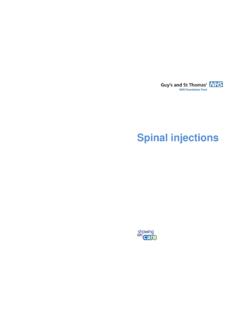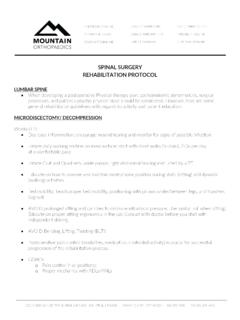Transcription of SPINAL CORD INJURY PATIENT HANDBOOK - Atrium Health
1 OneSPINAL cord INJURY PATIENT HANDBOOK CAROLINAS REHABILITATION | 2 INTRODUCTION 3 SECTION I 6 SPINAL cord INJURY Facts ..7 SPINAL cord INJURY Research ..11 SECTION II 12 Autonomic Dysreflexia ..13 Bladder Management ..18 Bowel Management ..40 Medications ..47 Pain Management ..55 Nutrition ..57 Respiratory System ..64 Skin Care ..75 SECTION III 85 Adaptive Equipment ..86 Hazards and Safety Precautions ..88 Mobile and Lower Extremity Range of Motion ..97 Driving ..110 Recreation ..128 SECTION IV 132 Sexuality for Men ..133 Sexuality for Women ..137 Wellness and Resilience ..145 SECTION V 159 Financial and Community Resources ..160 Emergency Modifications ..186 Ramp Specifications ..190 CAROLINAS REHABILITATION | 3 INTRODUCTIONAs part of Carolinas HealthCare System, Carolinas Rehabilitation has been helping people recover from INJURY and illness for more than 60 years.
2 Our goal is to restore each person to a life that is as full and rewarding as possible and to get that person back home as quickly as possible. That is our goal for you, HANDBOOK is part of how we will help you reach that goal. It contains key information that will help you understand your condition and tells you how to best manage the medical and physical challenges posed by your SPINAL cord INJURY . This HANDBOOK will help you continue your recovery once you leave the hospital. The information in this HANDBOOK is specially selected for you. What you will read is based upon the type of INJURY you had, where it was located in your spine, and your needs after you have left the after year, an outside research company has found that we return more people to their homes than most other rehabilitation hospitals in the South or anywhere else in the country. We attain these results by using an entire team of specialists to aid you during your team of specialists is called a care team.
3 You and your family are the most important members. Other members of your team include a physiatrist (a doctor who specializes in rehabilitation medicine), nurses, physical therapist, occupational therapist, social worker, and urology nurse. There are also nutritionists, vocational counselors, vocational evaluators, a chaplain, educational specialists, and others who will work with you if you need their services. Our team approach provides you with state-of-the-art care that is matched to your special REHABILITATION | 4 About Carolinas Rehabilitation Carolinas Rehabilitation is a not-for-profit rehabilitation hospital that was founded in 1950. It is a facility of Carolinas HealthCare System. With beds for 192 inpatients dealing with SPINAL cord injuries, strokes, brain injuries, amputations, bone injuries, cancer, and more, Carolinas Rehabilitation is one of the largest comprehensive rehabilitation centers in the Southeast. We also provide a long list of outpatient services to help patients continue their recovery after they have left the hospital.
4 You may be scheduled for some of these services after you leave the Rehabilitation is also a training center for doctors specializing in rehabilitation medicine as well as many other rehabilitation specialists. Our staff conducts rehabilitation research of many kinds and is continuously looking for better and more effective ways to help our patients. How to Use Your SPINAL cord INJURY HandbookYour level of recovery will depend largely on how hard you work in your therapies and your commitment to caring for yourself. To make sure you learn as much as possible, you should read this HANDBOOK carefully. The HANDBOOK is designed to complement the SPINAL cord INJURY Education class series. The class series is a one-hour educational class offered every afternoon from 3 to 4 Each class is taught by a member of the interdisciplinary team at Carolinas Rehabilitation. This team includes your occupational and physical therapists, recreational therapists, nutritionist, wheelchair seating specialist, among many others.
5 Your family is welcome to join these classes, and questions from all are encouraged. There are 10 classes total over a two week period, and the classes are interactive so you can learn as much about your INJURY and recovery as possible. Bring your HANDBOOK to your therapy sessions and education classes to reinforce what your therapists are teaching, and review your HANDBOOK to reinforce what you are something doesn t make sense or if you run across medical terminology you don t understand, ask about it. Your doctor, nurses, and therapists all understand how important it is that you learn everything you can. Questions are welcome. The quality of your future depends upon what you REHABILITATION | 5 When you leave the hospital, it will be up to you to put everything you learned into practice. Refer to it when you encounter new or difficult situations; it is like having a therapist with you. Finally, be sure to bring your HANDBOOK when you see your family doctor or visit the clinic.
6 It can help your doctor understand more about how to handle your SPINAL cord INJURY and it is a handy place to add new information. You should also bring it when you return to Carolinas Rehabilitation for a clinic visit or outpatient Final ThoughtWe want to wish you the best in your recovery, and we re honored that you chose Carolinas Rehabilitation to help with your recovery. We will do everything we can to make your stay here as successful as possible. OneSECTION I SECTION ICAROLINAS REHABILITATION | 7 SPINAL cord INJURY FACTSS pinal cord InjuriesA SPINAL cord INJURY is caused by trauma or disease to the SPINAL cord , most often resulting in paralysis (loss of strength), loss of sensation (feeling), and loss of control of bodily , there are approximately 273,000 people in the United States who have SPINAL cord INJURY with 12,000 new injuries each 2010, the average age at INJURY is years of age, with percent of injuries occurring in men.
7 There has also been an increase in the number of persons over 60 who have SPINAL cord of SPINAL cord Injuries Since 2010 Vehicular accidents - Falls - Violence - Sports - Other/unknown Paralysis, or loss of muscle strength, is the initial source of medical problems in persons with SPINAL cord injuries. Secondary medical problems include demineralization of bone, degeneration of the circulatory system, kidney and bladder dysfunction, pneumonia, and pressure sores. The average person who sustains a SPINAL cord INJURY can expect to be in rehab for three to four weeks and spend $400,000 on medical care. percent of all persons with SCI are discharged from rehab to their private home, usually returning to their residence before the INJURY . At the time of the INJURY , percent of persons sustaining a SCI were employed. After one year, percent of those with an SCI are employed, and after 10 years, percent are employed.
8 (Information from the National SPINAL cord INJURY Statistical Center, Birmingham, AL, ) SECTION ICAROLINAS REHABILITATION | 8 The Normal SPINAL CordYour brain is a lot like a computer for your body. It sends and receives messages from all parts of your body and handles all the complicated functions of your body. The SPINAL cord is the pathway traveled by the messages between the brain and other parts of your SPINAL cord is made up of many nerve fibers. The SPINAL cord is surrounded and protected by round bones called vertebrae. The vertebrae are stacked one on top of another like a chain, also called a backbone. The SPINAL nerves branch off the SPINAL cord between the vertebrae along the neck and back. These SPINAL nerves carry sensory and motor information. Sensory refers to your ability to feel, and motor refers to your ability to move. The sensory information goes from your arms and legs to your brain and the motor information goes from your brain to your arms and CordSpinal NervesVertebrae SECTION ICAROLINAS REHABILITATION | 9 The SPINAL cord After an INJURY With a SPINAL cord INJURY , all the nerves above the INJURY keep working like they always have.
9 Below the INJURY , feelings like hot, cold and pain can t get to the brain, and messages from the brain asking for movement can t get to the muscles. The closer the INJURY is to the brain the more of your body will have no feeling and the more muscle weakness you will experience. For example, someone with a T8 INJURY will typically have more feeling and movement than someone with a C5 INJURY . In addition to affecting movement and feeling, a SPINAL cord INJURY affects some body functions, such as bowel, bladder and sexual Vertebrae C1 C7 Thoracic Vertebrae T1 T12 Lumbar Vertebrae L1 L5 Sacral Vertebrae SECTION ICAROLINAS REHABILITATION | 10 Types of SPINAL cord InjuryThe SPINAL cord damage can be severe where no information (feeling or movement) is able to pass the area of damage in the SPINAL cord . In a less severe case, some messages are able to pass the damaged area. The amount and type of messages that can pass will depend on how many of the nerves are damaged in the SPINAL cord .
10 Some people may have a lot of feeling, but little movement. Others may have some movement and very little feeling. SPINAL cord injuries will be different from one person to another because of the different nerves that are damaged. Sometimes the SPINAL cord is only bruised or swollen. With time, the nerves may heal and begin to work again. We do not have any tests at this time to predict which nerves (if any) will begin to work after SPINAL cord use a scale called ASIA (American SPINAL INJURY Association) Impairment Scale to determine the degree of damage to the SPINAL cord . Your doctor and therapists will test you to see which areas of your body have normal or impaired feeling and normal or impaired movement. This helps to determine how severe the damage was to the SPINAL cord and will be continually monitored for Impairment Scale ASIA A: means there is no feeling or movement below the damaged area in the SPINAL cord ASIA B: feeling, but no muscle strength, is present below the damaged area ASIA C: weak muscle strength is present below the damaged area ASIA D: strong muscle function is present below the damaged area ASIA E: feeling and muscle function is normal below the damaged area of the SPINAL cord SECTION ICAROLINAS REHABILITATION | 11 SPINAL cord INJURY RESEARCHThe physicians, nurses and clinicians at Carolinas HealthCare System are actively involved in several research studies related to SPINAL cord INJURY treatment.


